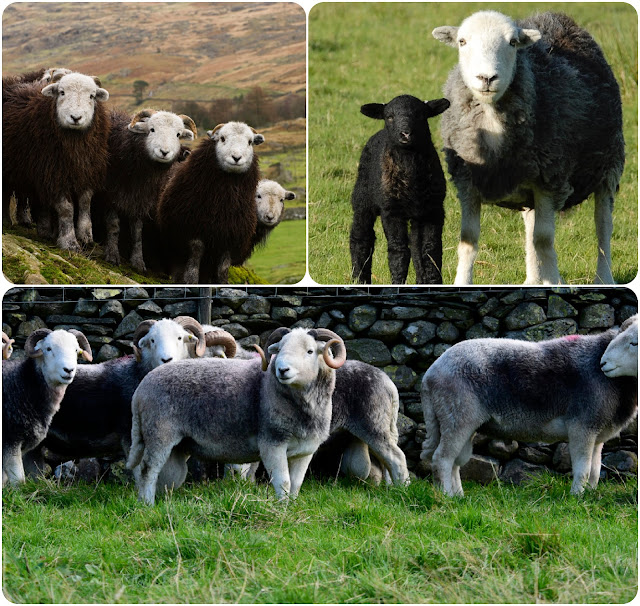Herdwick Sheep have been roaming across the fells of the Lake District since at least the 12th century when the name appears in writings as Herdwyck or Herdvyck, which is Norse for "Sheep Pasture" which gives credibility for the theory that these originated in Scandinavia, having being with bought here by the Vikings.
 |
| Top right: young sheep about 1 year old Top left: Ewe and newborn lamb Bottom: Mature rams |
The Herdwick is a medium build sheep with a white head and legs. They are regarded as the most hardy of all of the British breeds and can survive on the highest ground. Their fleece sheds water more efficiently than other fleeces and also dries out more quickly. Lambs are born totally black but their faces, ears and legs soon turn white and by the time they are 1 year old their fleece has become dark brown. The fleece becomes lighter year on year and the oldest sheep can reach the point of having an all white fleece. They should have a strong ruffle or mane around the neck and top of the shoulder and this generally contains more coarse fibres than the rest of the fleece. Rams are usually horned, ewes are polled.
They produce a medium size fleece of 1.5-2kg in weight that contains an undercoat of relatively soft wool, guard hairs, heterotypic hair which change with the season so are more wool like for warmth in winter and more hair-like for shedding rain in the summer and then there is kemp. Sometimes there is a lot of kemp. It is easier to prepare when it is long because although these fibres are happy to hang out together if you want to separate them then its easier to do so when the fleece is longer. It is also easier to spin this if the fibres are longer than short.
The staple lengths can range 3-10 inches (7.5-25.5cm) but are generally 4-8 inches (10-20.5cm). The locks are dense and clumpy and tend to contain a mix of the four fibre types with the mane area being the coarsest. They are usually grey, although lambs are black through to brown so you might be able to get black or brown fleece if you can get a lamb or shearling fleece or you may be able to get a tan brown fleece from a sheep being sheared for the second time. The kemp fibres will not show dye much, if at all, and darker fleece won't show any colour but the lighter grey fleeces may show dye, although it will be like undyed wool and be tweedy.
This fleece can be spun from teased locks. Combing may separate some of the fibre types and carding is best for shorter fleeces. If you intend to spin all the fibre types into your yarn then you need to use the lightest touch to keep them well blended otherwise they will be effectively filtered by your hand and spun separately. You need enough twist to hold it together but not much that you make rope.
Yarns spun from Herdwick fleece are definitely suited to household items and upholstery, especially if all fibre types have been spun together. If you have separated the soft undercoat out from the rest of the fleece and spun that then those yarns might be suitable for hats, sweaters and such like but still not likely to be used for next to skin wear.
 |




No comments:
Post a Comment